Assignment On Formal Organizational
VerifiedAdded on 2022/10/04
|19
|3928
|19
Assignment
AI Summary
Contribute Materials
Your contribution can guide someone’s learning journey. Share your
documents today.
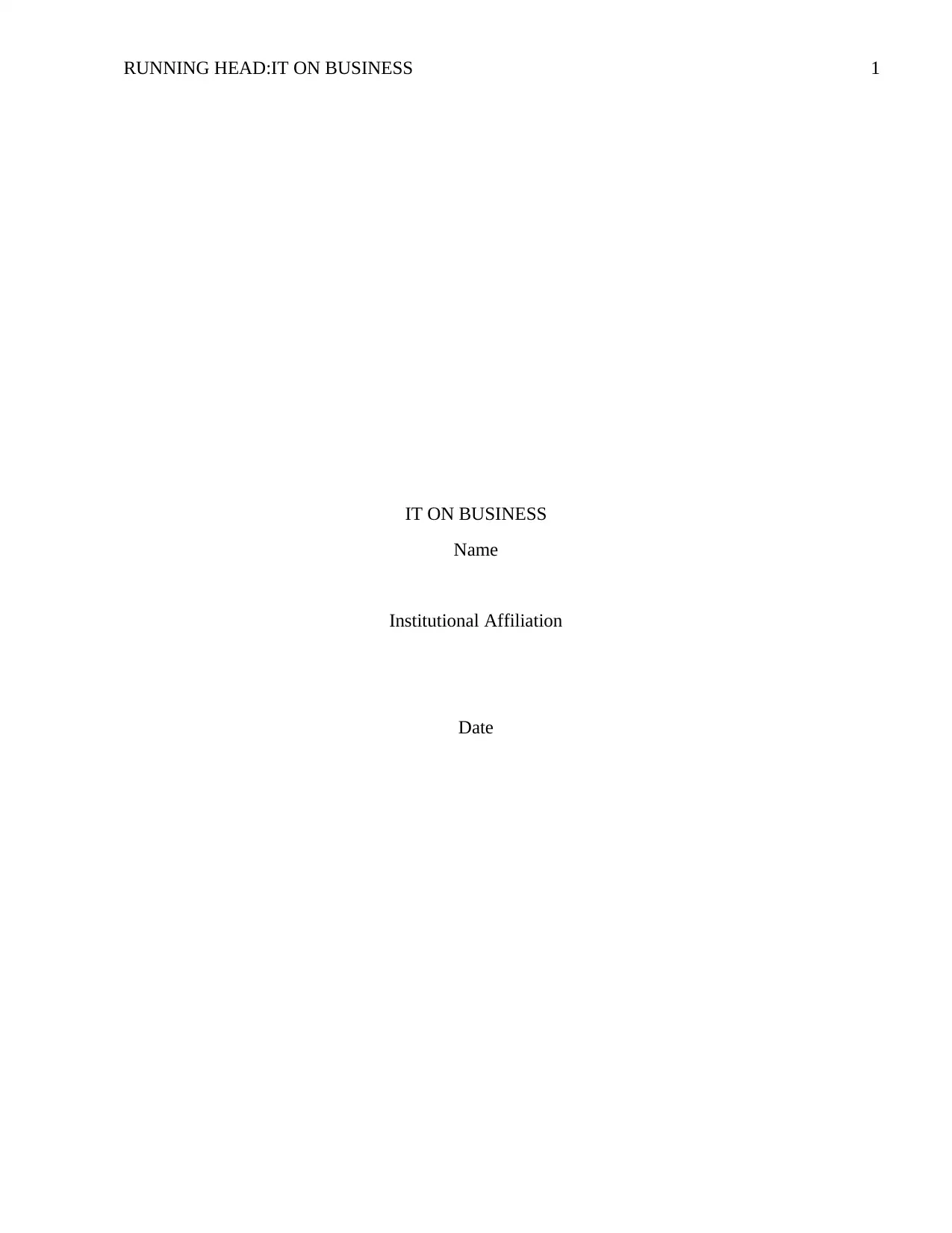
RUNNING HEAD:IT ON BUSINESS 1
IT ON BUSINESS
Name
Institutional Affiliation
Date
IT ON BUSINESS
Name
Institutional Affiliation
Date
Secure Best Marks with AI Grader
Need help grading? Try our AI Grader for instant feedback on your assignments.
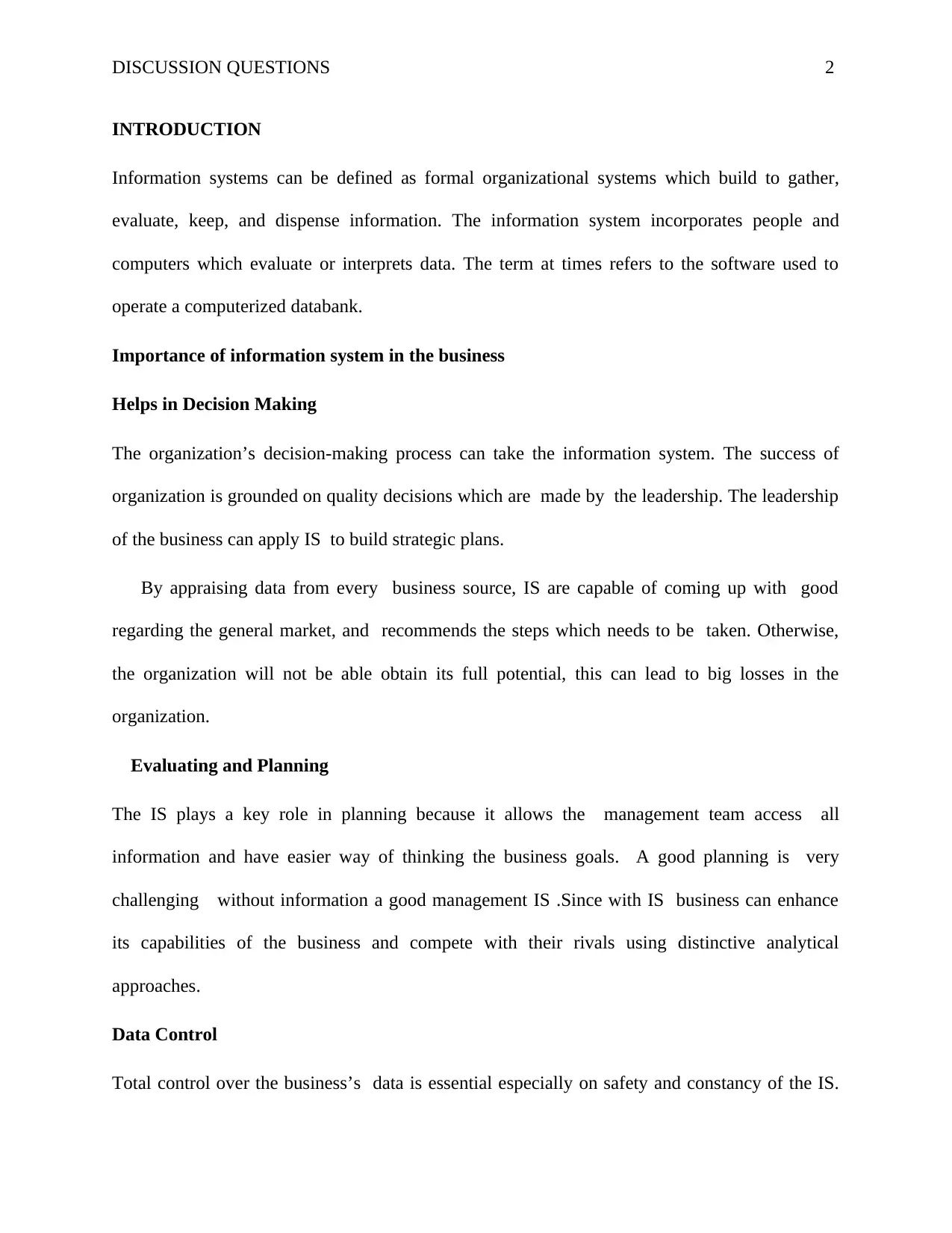
DISCUSSION QUESTIONS 2
INTRODUCTION
Information systems can be defined as formal organizational systems which build to gather,
evaluate, keep, and dispense information. The information system incorporates people and
computers which evaluate or interprets data. The term at times refers to the software used to
operate a computerized databank.
Importance of information system in the business
Helps in Decision Making
The organization’s decision-making process can take the information system. The success of
organization is grounded on quality decisions which are made by the leadership. The leadership
of the business can apply IS to build strategic plans.
By appraising data from every business source, IS are capable of coming up with good
regarding the general market, and recommends the steps which needs to be taken. Otherwise,
the organization will not be able obtain its full potential, this can lead to big losses in the
organization.
Evaluating and Planning
The IS plays a key role in planning because it allows the management team access all
information and have easier way of thinking the business goals. A good planning is very
challenging without information a good management IS .Since with IS business can enhance
its capabilities of the business and compete with their rivals using distinctive analytical
approaches.
Data Control
Total control over the business’s data is essential especially on safety and constancy of the IS.
INTRODUCTION
Information systems can be defined as formal organizational systems which build to gather,
evaluate, keep, and dispense information. The information system incorporates people and
computers which evaluate or interprets data. The term at times refers to the software used to
operate a computerized databank.
Importance of information system in the business
Helps in Decision Making
The organization’s decision-making process can take the information system. The success of
organization is grounded on quality decisions which are made by the leadership. The leadership
of the business can apply IS to build strategic plans.
By appraising data from every business source, IS are capable of coming up with good
regarding the general market, and recommends the steps which needs to be taken. Otherwise,
the organization will not be able obtain its full potential, this can lead to big losses in the
organization.
Evaluating and Planning
The IS plays a key role in planning because it allows the management team access all
information and have easier way of thinking the business goals. A good planning is very
challenging without information a good management IS .Since with IS business can enhance
its capabilities of the business and compete with their rivals using distinctive analytical
approaches.
Data Control
Total control over the business’s data is essential especially on safety and constancy of the IS.
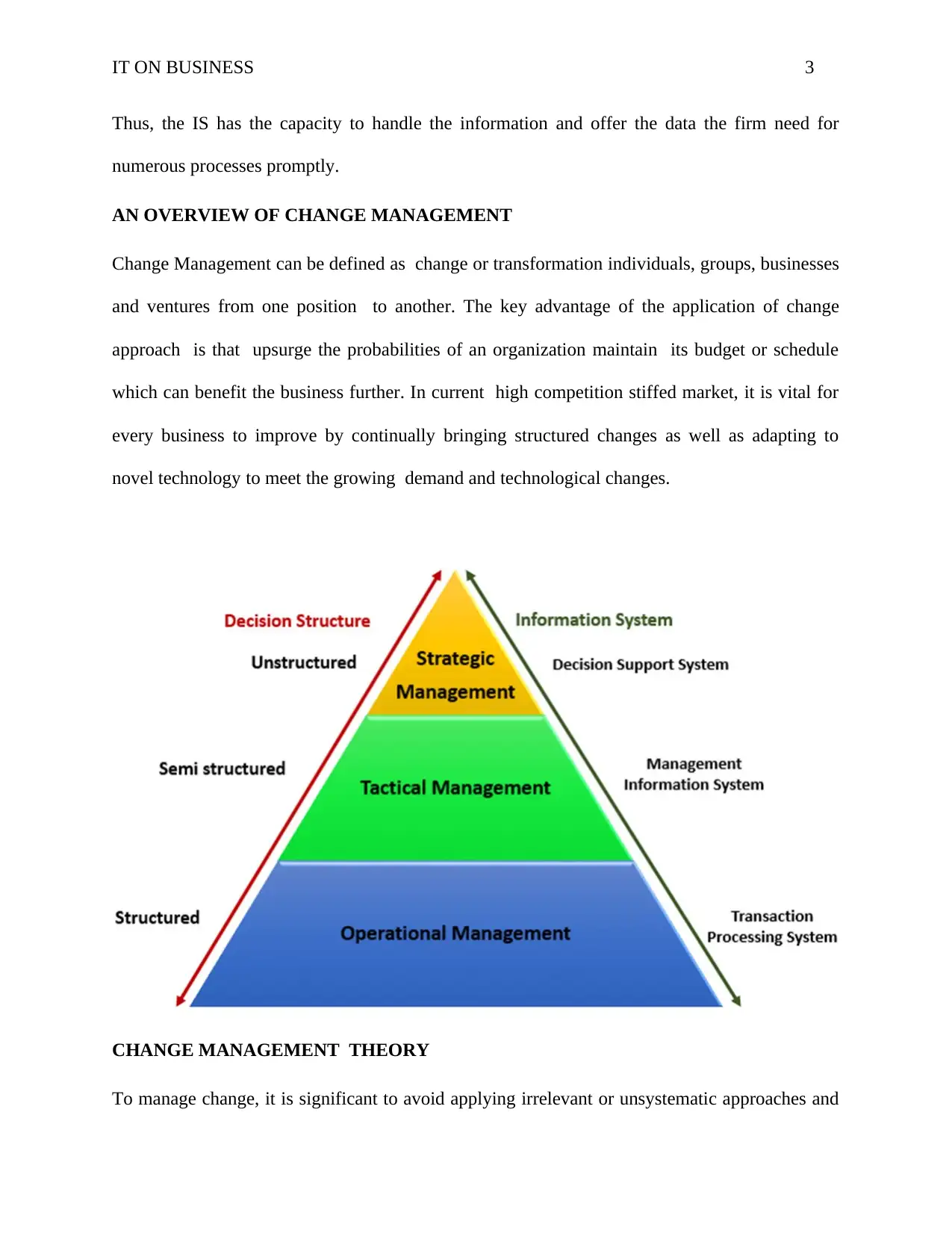
IT ON BUSINESS 3
Thus, the IS has the capacity to handle the information and offer the data the firm need for
numerous processes promptly.
AN OVERVIEW OF CHANGE MANAGEMENT
Change Management can be defined as change or transformation individuals, groups, businesses
and ventures from one position to another. The key advantage of the application of change
approach is that upsurge the probabilities of an organization maintain its budget or schedule
which can benefit the business further. In current high competition stiffed market, it is vital for
every business to improve by continually bringing structured changes as well as adapting to
novel technology to meet the growing demand and technological changes.
CHANGE MANAGEMENT THEORY
To manage change, it is significant to avoid applying irrelevant or unsystematic approaches and
Thus, the IS has the capacity to handle the information and offer the data the firm need for
numerous processes promptly.
AN OVERVIEW OF CHANGE MANAGEMENT
Change Management can be defined as change or transformation individuals, groups, businesses
and ventures from one position to another. The key advantage of the application of change
approach is that upsurge the probabilities of an organization maintain its budget or schedule
which can benefit the business further. In current high competition stiffed market, it is vital for
every business to improve by continually bringing structured changes as well as adapting to
novel technology to meet the growing demand and technological changes.
CHANGE MANAGEMENT THEORY
To manage change, it is significant to avoid applying irrelevant or unsystematic approaches and
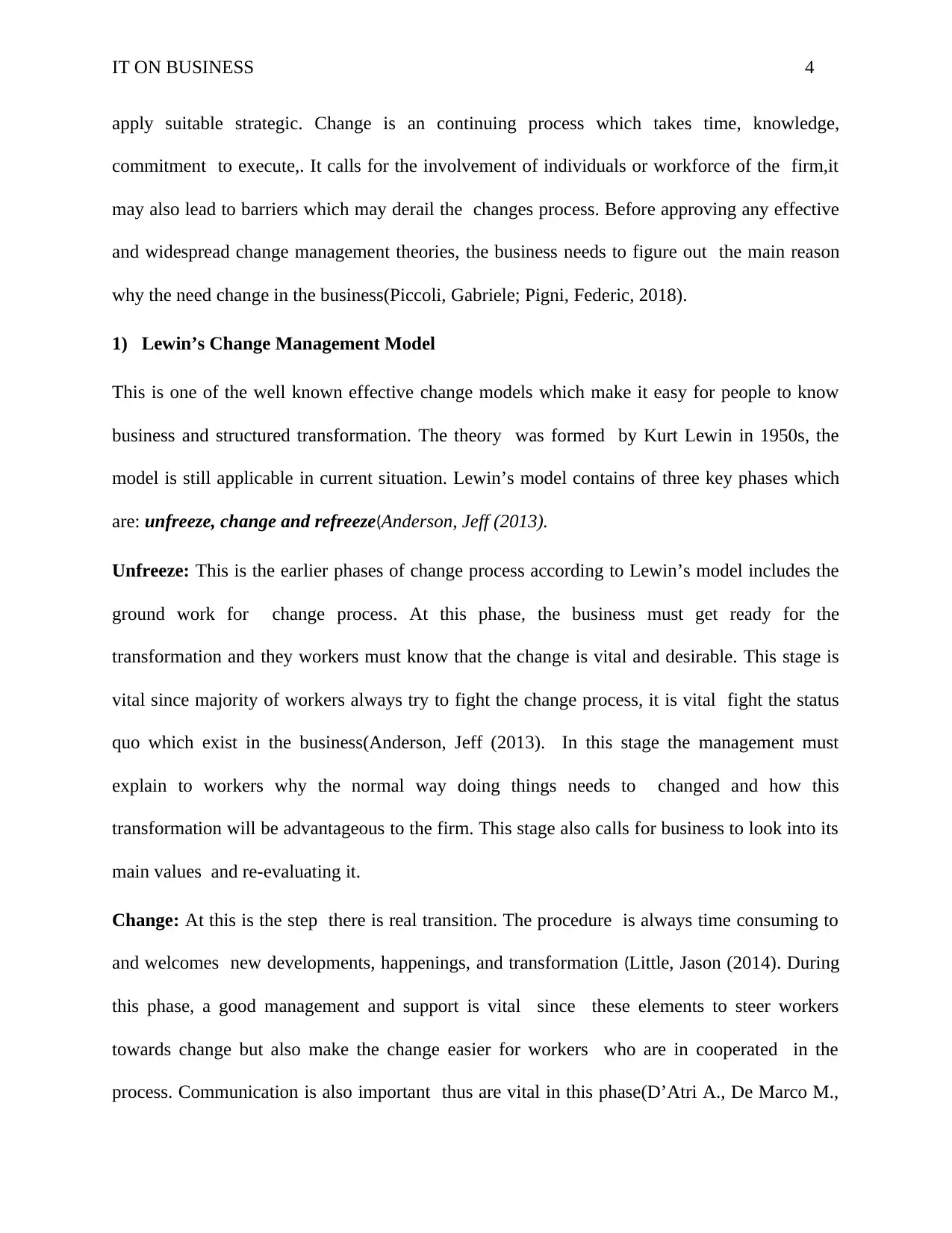
IT ON BUSINESS 4
apply suitable strategic. Change is an continuing process which takes time, knowledge,
commitment to execute,. It calls for the involvement of individuals or workforce of the firm,it
may also lead to barriers which may derail the changes process. Before approving any effective
and widespread change management theories, the business needs to figure out the main reason
why the need change in the business(Piccoli, Gabriele; Pigni, Federic, 2018).
1) Lewin’s Change Management Model
This is one of the well known effective change models which make it easy for people to know
business and structured transformation. The theory was formed by Kurt Lewin in 1950s, the
model is still applicable in current situation. Lewin’s model contains of three key phases which
are: unfreeze, change and refreeze(Anderson, Jeff (2013).
Unfreeze: This is the earlier phases of change process according to Lewin’s model includes the
ground work for change process. At this phase, the business must get ready for the
transformation and they workers must know that the change is vital and desirable. This stage is
vital since majority of workers always try to fight the change process, it is vital fight the status
quo which exist in the business(Anderson, Jeff (2013). In this stage the management must
explain to workers why the normal way doing things needs to changed and how this
transformation will be advantageous to the firm. This stage also calls for business to look into its
main values and re-evaluating it.
Change: At this is the step there is real transition. The procedure is always time consuming to
and welcomes new developments, happenings, and transformation (Little, Jason (2014). During
this phase, a good management and support is vital since these elements to steer workers
towards change but also make the change easier for workers who are in cooperated in the
process. Communication is also important thus are vital in this phase(D’Atri A., De Marco M.,
apply suitable strategic. Change is an continuing process which takes time, knowledge,
commitment to execute,. It calls for the involvement of individuals or workforce of the firm,it
may also lead to barriers which may derail the changes process. Before approving any effective
and widespread change management theories, the business needs to figure out the main reason
why the need change in the business(Piccoli, Gabriele; Pigni, Federic, 2018).
1) Lewin’s Change Management Model
This is one of the well known effective change models which make it easy for people to know
business and structured transformation. The theory was formed by Kurt Lewin in 1950s, the
model is still applicable in current situation. Lewin’s model contains of three key phases which
are: unfreeze, change and refreeze(Anderson, Jeff (2013).
Unfreeze: This is the earlier phases of change process according to Lewin’s model includes the
ground work for change process. At this phase, the business must get ready for the
transformation and they workers must know that the change is vital and desirable. This stage is
vital since majority of workers always try to fight the change process, it is vital fight the status
quo which exist in the business(Anderson, Jeff (2013). In this stage the management must
explain to workers why the normal way doing things needs to changed and how this
transformation will be advantageous to the firm. This stage also calls for business to look into its
main values and re-evaluating it.
Change: At this is the step there is real transition. The procedure is always time consuming to
and welcomes new developments, happenings, and transformation (Little, Jason (2014). During
this phase, a good management and support is vital since these elements to steer workers
towards change but also make the change easier for workers who are in cooperated in the
process. Communication is also important thus are vital in this phase(D’Atri A., De Marco M.,
Secure Best Marks with AI Grader
Need help grading? Try our AI Grader for instant feedback on your assignments.
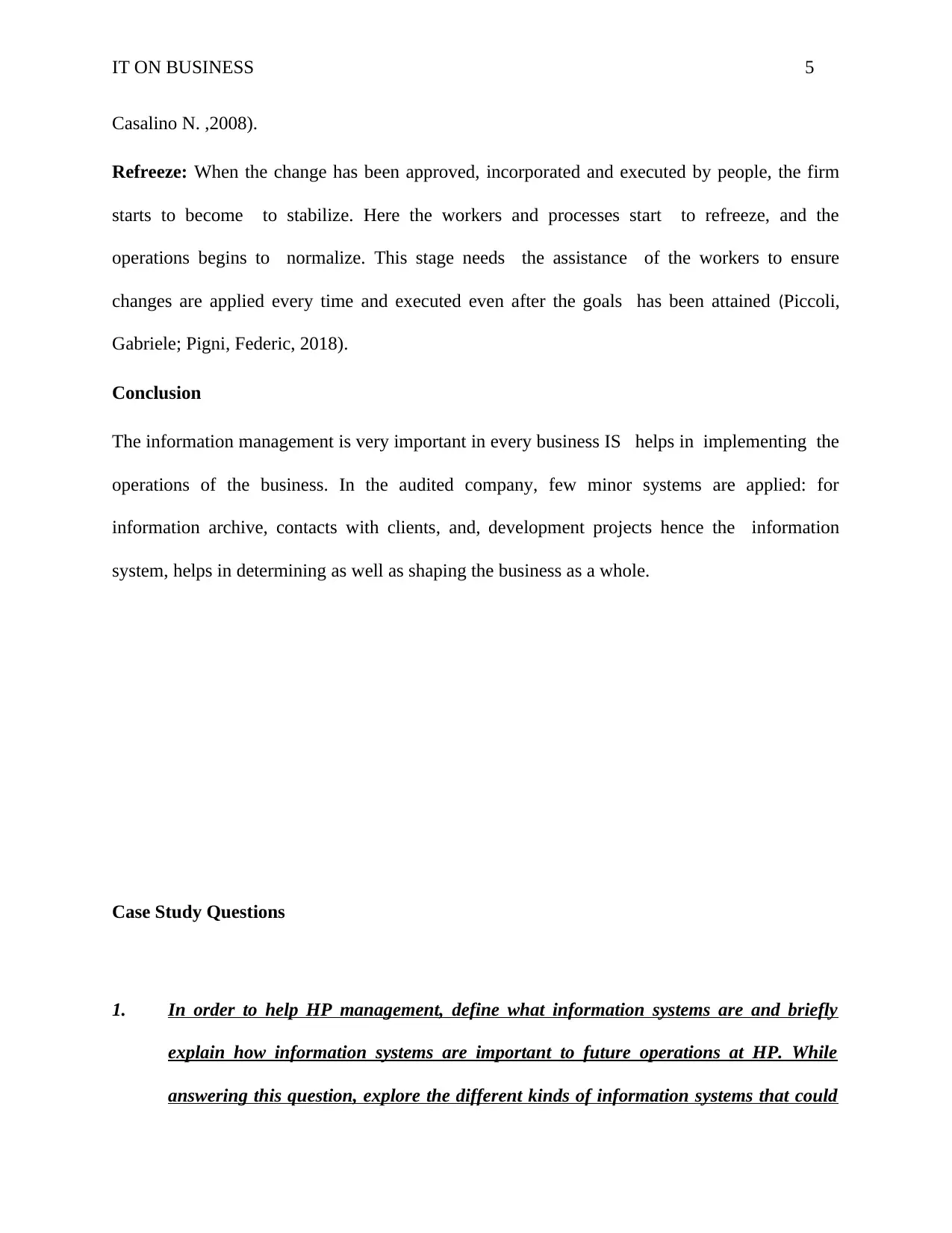
IT ON BUSINESS 5
Casalino N. ,2008).
Refreeze: When the change has been approved, incorporated and executed by people, the firm
starts to become to stabilize. Here the workers and processes start to refreeze, and the
operations begins to normalize. This stage needs the assistance of the workers to ensure
changes are applied every time and executed even after the goals has been attained (Piccoli,
Gabriele; Pigni, Federic, 2018).
Conclusion
The information management is very important in every business IS helps in implementing the
operations of the business. In the audited company, few minor systems are applied: for
information archive, contacts with clients, and, development projects hence the information
system, helps in determining as well as shaping the business as a whole.
Case Study Questions
1. In order to help HP management, define what information systems are and briefly
explain how information systems are important to future operations at HP. While
answering this question, explore the different kinds of information systems that could
Casalino N. ,2008).
Refreeze: When the change has been approved, incorporated and executed by people, the firm
starts to become to stabilize. Here the workers and processes start to refreeze, and the
operations begins to normalize. This stage needs the assistance of the workers to ensure
changes are applied every time and executed even after the goals has been attained (Piccoli,
Gabriele; Pigni, Federic, 2018).
Conclusion
The information management is very important in every business IS helps in implementing the
operations of the business. In the audited company, few minor systems are applied: for
information archive, contacts with clients, and, development projects hence the information
system, helps in determining as well as shaping the business as a whole.
Case Study Questions
1. In order to help HP management, define what information systems are and briefly
explain how information systems are important to future operations at HP. While
answering this question, explore the different kinds of information systems that could
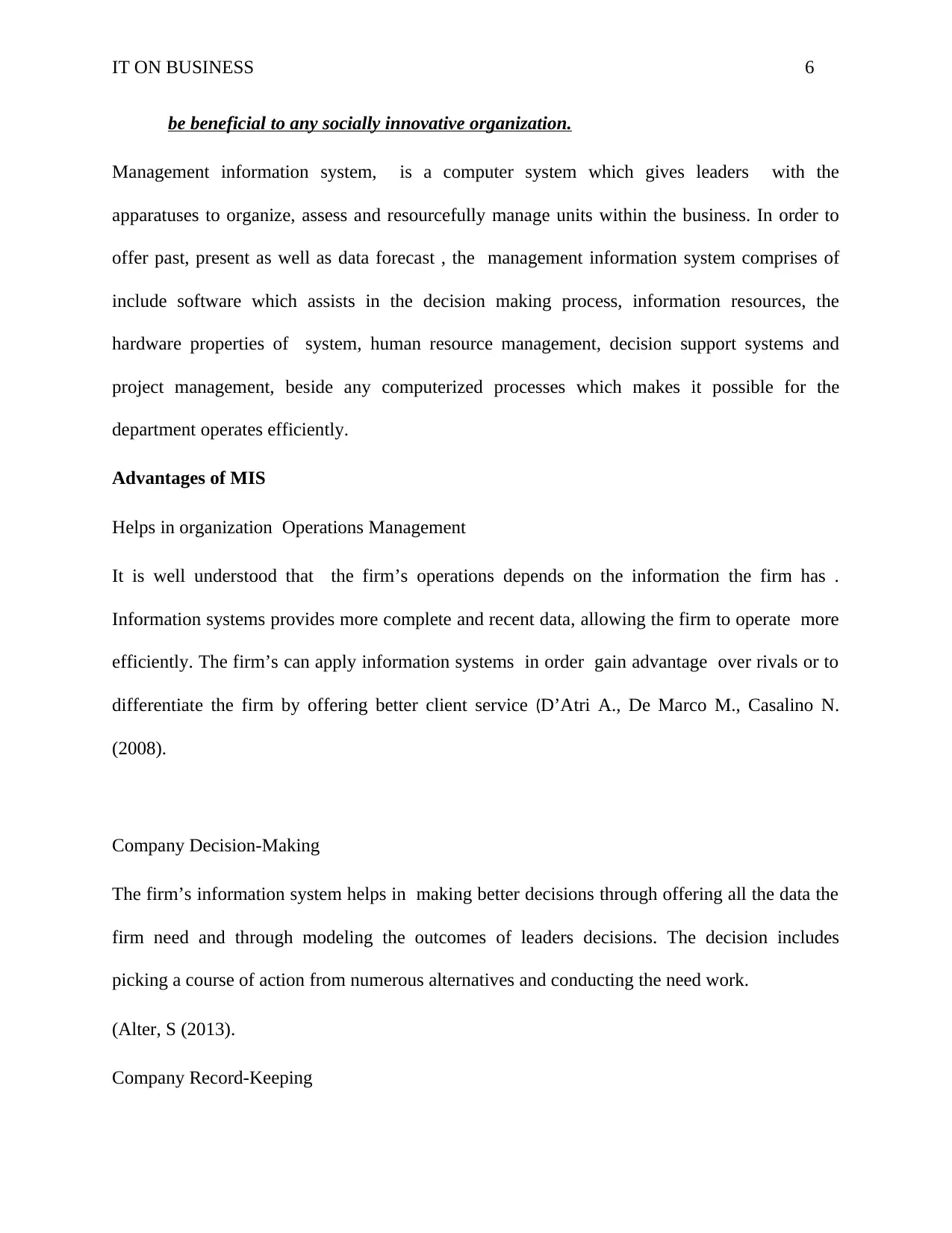
IT ON BUSINESS 6
be beneficial to any socially innovative organization.
Management information system, is a computer system which gives leaders with the
apparatuses to organize, assess and resourcefully manage units within the business. In order to
offer past, present as well as data forecast , the management information system comprises of
include software which assists in the decision making process, information resources, the
hardware properties of system, human resource management, decision support systems and
project management, beside any computerized processes which makes it possible for the
department operates efficiently.
Advantages of MIS
Helps in organization Operations Management
It is well understood that the firm’s operations depends on the information the firm has .
Information systems provides more complete and recent data, allowing the firm to operate more
efficiently. The firm’s can apply information systems in order gain advantage over rivals or to
differentiate the firm by offering better client service (D’Atri A., De Marco M., Casalino N.
(2008).
Company Decision-Making
The firm’s information system helps in making better decisions through offering all the data the
firm need and through modeling the outcomes of leaders decisions. The decision includes
picking a course of action from numerous alternatives and conducting the need work.
(Alter, S (2013).
Company Record-Keeping
be beneficial to any socially innovative organization.
Management information system, is a computer system which gives leaders with the
apparatuses to organize, assess and resourcefully manage units within the business. In order to
offer past, present as well as data forecast , the management information system comprises of
include software which assists in the decision making process, information resources, the
hardware properties of system, human resource management, decision support systems and
project management, beside any computerized processes which makes it possible for the
department operates efficiently.
Advantages of MIS
Helps in organization Operations Management
It is well understood that the firm’s operations depends on the information the firm has .
Information systems provides more complete and recent data, allowing the firm to operate more
efficiently. The firm’s can apply information systems in order gain advantage over rivals or to
differentiate the firm by offering better client service (D’Atri A., De Marco M., Casalino N.
(2008).
Company Decision-Making
The firm’s information system helps in making better decisions through offering all the data the
firm need and through modeling the outcomes of leaders decisions. The decision includes
picking a course of action from numerous alternatives and conducting the need work.
(Alter, S (2013).
Company Record-Keeping
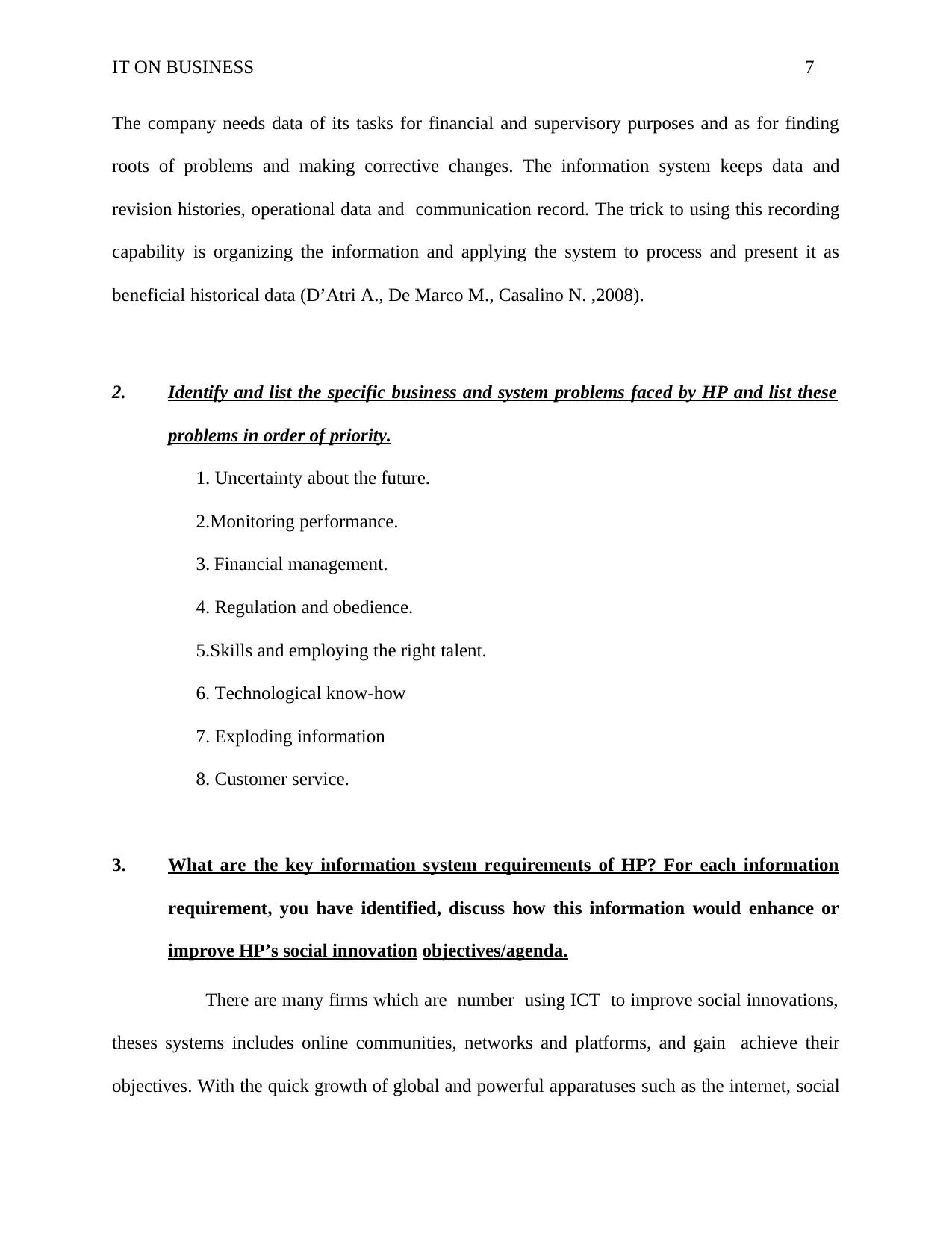
IT ON BUSINESS 7
The company needs data of its tasks for financial and supervisory purposes and as for finding
roots of problems and making corrective changes. The information system keeps data and
revision histories, operational data and communication record. The trick to using this recording
capability is organizing the information and applying the system to process and present it as
beneficial historical data (D’Atri A., De Marco M., Casalino N. ,2008).
2. Identify and list the specific business and system problems faced by HP and list these
problems in order of priority.
1. Uncertainty about the future.
2.Monitoring performance.
3. Financial management.
4. Regulation and obedience.
5.Skills and employing the right talent.
6. Technological know-how
7. Exploding information
8. Customer service.
3. What are the key information system requirements of HP? For each information
requirement, you have identified, discuss how this information would enhance or
improve HP’s social innovation objectives/agenda.
There are many firms which are number using ICT to improve social innovations,
theses systems includes online communities, networks and platforms, and gain achieve their
objectives. With the quick growth of global and powerful apparatuses such as the internet, social
The company needs data of its tasks for financial and supervisory purposes and as for finding
roots of problems and making corrective changes. The information system keeps data and
revision histories, operational data and communication record. The trick to using this recording
capability is organizing the information and applying the system to process and present it as
beneficial historical data (D’Atri A., De Marco M., Casalino N. ,2008).
2. Identify and list the specific business and system problems faced by HP and list these
problems in order of priority.
1. Uncertainty about the future.
2.Monitoring performance.
3. Financial management.
4. Regulation and obedience.
5.Skills and employing the right talent.
6. Technological know-how
7. Exploding information
8. Customer service.
3. What are the key information system requirements of HP? For each information
requirement, you have identified, discuss how this information would enhance or
improve HP’s social innovation objectives/agenda.
There are many firms which are number using ICT to improve social innovations,
theses systems includes online communities, networks and platforms, and gain achieve their
objectives. With the quick growth of global and powerful apparatuses such as the internet, social
Paraphrase This Document
Need a fresh take? Get an instant paraphrase of this document with our AI Paraphraser
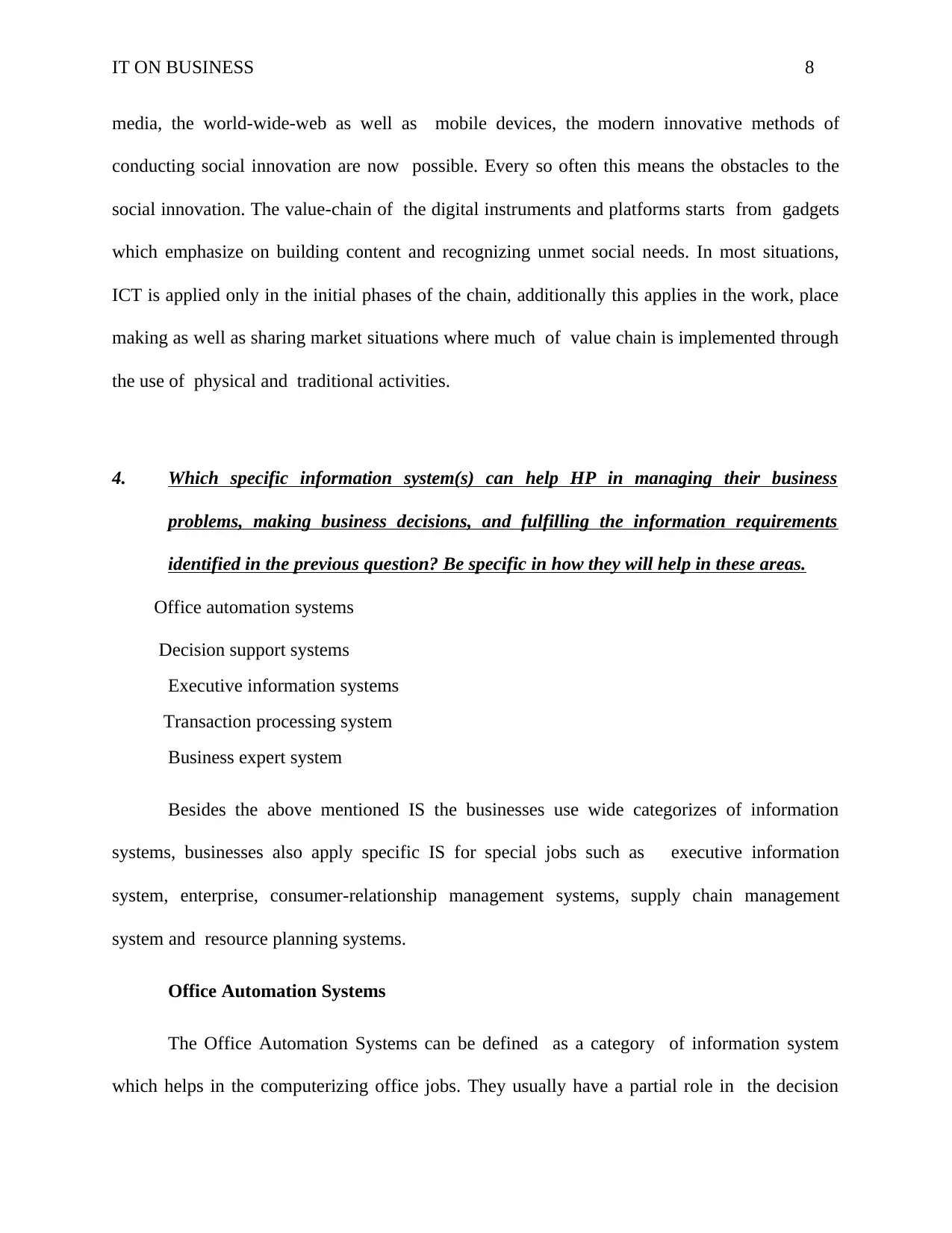
IT ON BUSINESS 8
media, the world-wide-web as well as mobile devices, the modern innovative methods of
conducting social innovation are now possible. Every so often this means the obstacles to the
social innovation. The value-chain of the digital instruments and platforms starts from gadgets
which emphasize on building content and recognizing unmet social needs. In most situations,
ICT is applied only in the initial phases of the chain, additionally this applies in the work, place
making as well as sharing market situations where much of value chain is implemented through
the use of physical and traditional activities.
4. Which specific information system(s) can help HP in managing their business
problems, making business decisions, and fulfilling the information requirements
identified in the previous question? Be specific in how they will help in these areas.
Office automation systems
Decision support systems
Executive information systems
Transaction processing system
Business expert system
Besides the above mentioned IS the businesses use wide categorizes of information
systems, businesses also apply specific IS for special jobs such as executive information
system, enterprise, consumer-relationship management systems, supply chain management
system and resource planning systems.
Office Automation Systems
The Office Automation Systems can be defined as a category of information system
which helps in the computerizing office jobs. They usually have a partial role in the decision
media, the world-wide-web as well as mobile devices, the modern innovative methods of
conducting social innovation are now possible. Every so often this means the obstacles to the
social innovation. The value-chain of the digital instruments and platforms starts from gadgets
which emphasize on building content and recognizing unmet social needs. In most situations,
ICT is applied only in the initial phases of the chain, additionally this applies in the work, place
making as well as sharing market situations where much of value chain is implemented through
the use of physical and traditional activities.
4. Which specific information system(s) can help HP in managing their business
problems, making business decisions, and fulfilling the information requirements
identified in the previous question? Be specific in how they will help in these areas.
Office automation systems
Decision support systems
Executive information systems
Transaction processing system
Business expert system
Besides the above mentioned IS the businesses use wide categorizes of information
systems, businesses also apply specific IS for special jobs such as executive information
system, enterprise, consumer-relationship management systems, supply chain management
system and resource planning systems.
Office Automation Systems
The Office Automation Systems can be defined as a category of information system
which helps in the computerizing office jobs. They usually have a partial role in the decision
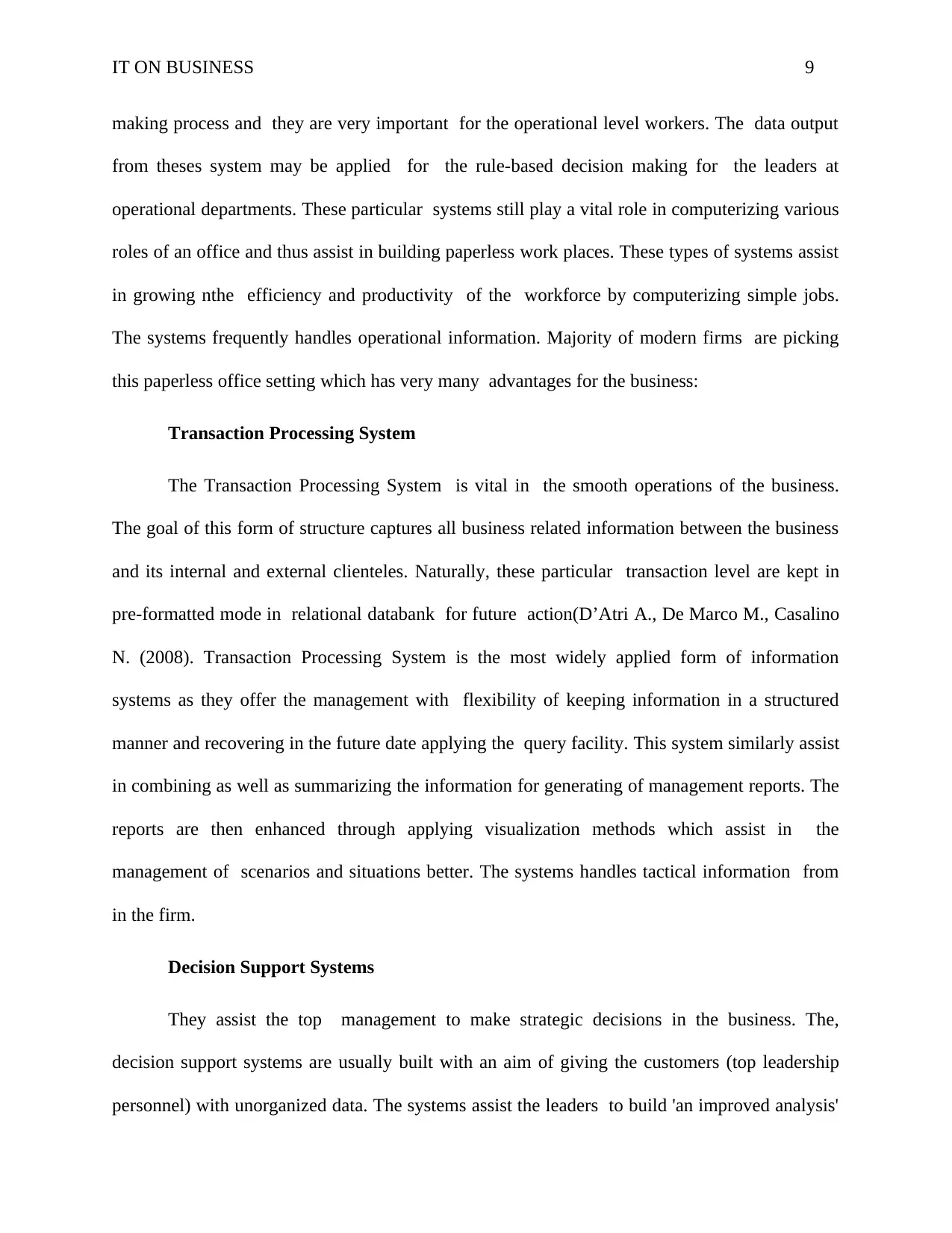
IT ON BUSINESS 9
making process and they are very important for the operational level workers. The data output
from theses system may be applied for the rule-based decision making for the leaders at
operational departments. These particular systems still play a vital role in computerizing various
roles of an office and thus assist in building paperless work places. These types of systems assist
in growing nthe efficiency and productivity of the workforce by computerizing simple jobs.
The systems frequently handles operational information. Majority of modern firms are picking
this paperless office setting which has very many advantages for the business:
Transaction Processing System
The Transaction Processing System is vital in the smooth operations of the business.
The goal of this form of structure captures all business related information between the business
and its internal and external clienteles. Naturally, these particular transaction level are kept in
pre-formatted mode in relational databank for future action(D’Atri A., De Marco M., Casalino
N. (2008). Transaction Processing System is the most widely applied form of information
systems as they offer the management with flexibility of keeping information in a structured
manner and recovering in the future date applying the query facility. This system similarly assist
in combining as well as summarizing the information for generating of management reports. The
reports are then enhanced through applying visualization methods which assist in the
management of scenarios and situations better. The systems handles tactical information from
in the firm.
Decision Support Systems
They assist the top management to make strategic decisions in the business. The,
decision support systems are usually built with an aim of giving the customers (top leadership
personnel) with unorganized data. The systems assist the leaders to build 'an improved analysis'
making process and they are very important for the operational level workers. The data output
from theses system may be applied for the rule-based decision making for the leaders at
operational departments. These particular systems still play a vital role in computerizing various
roles of an office and thus assist in building paperless work places. These types of systems assist
in growing nthe efficiency and productivity of the workforce by computerizing simple jobs.
The systems frequently handles operational information. Majority of modern firms are picking
this paperless office setting which has very many advantages for the business:
Transaction Processing System
The Transaction Processing System is vital in the smooth operations of the business.
The goal of this form of structure captures all business related information between the business
and its internal and external clienteles. Naturally, these particular transaction level are kept in
pre-formatted mode in relational databank for future action(D’Atri A., De Marco M., Casalino
N. (2008). Transaction Processing System is the most widely applied form of information
systems as they offer the management with flexibility of keeping information in a structured
manner and recovering in the future date applying the query facility. This system similarly assist
in combining as well as summarizing the information for generating of management reports. The
reports are then enhanced through applying visualization methods which assist in the
management of scenarios and situations better. The systems handles tactical information from
in the firm.
Decision Support Systems
They assist the top management to make strategic decisions in the business. The,
decision support systems are usually built with an aim of giving the customers (top leadership
personnel) with unorganized data. The systems assist the leaders to build 'an improved analysis'
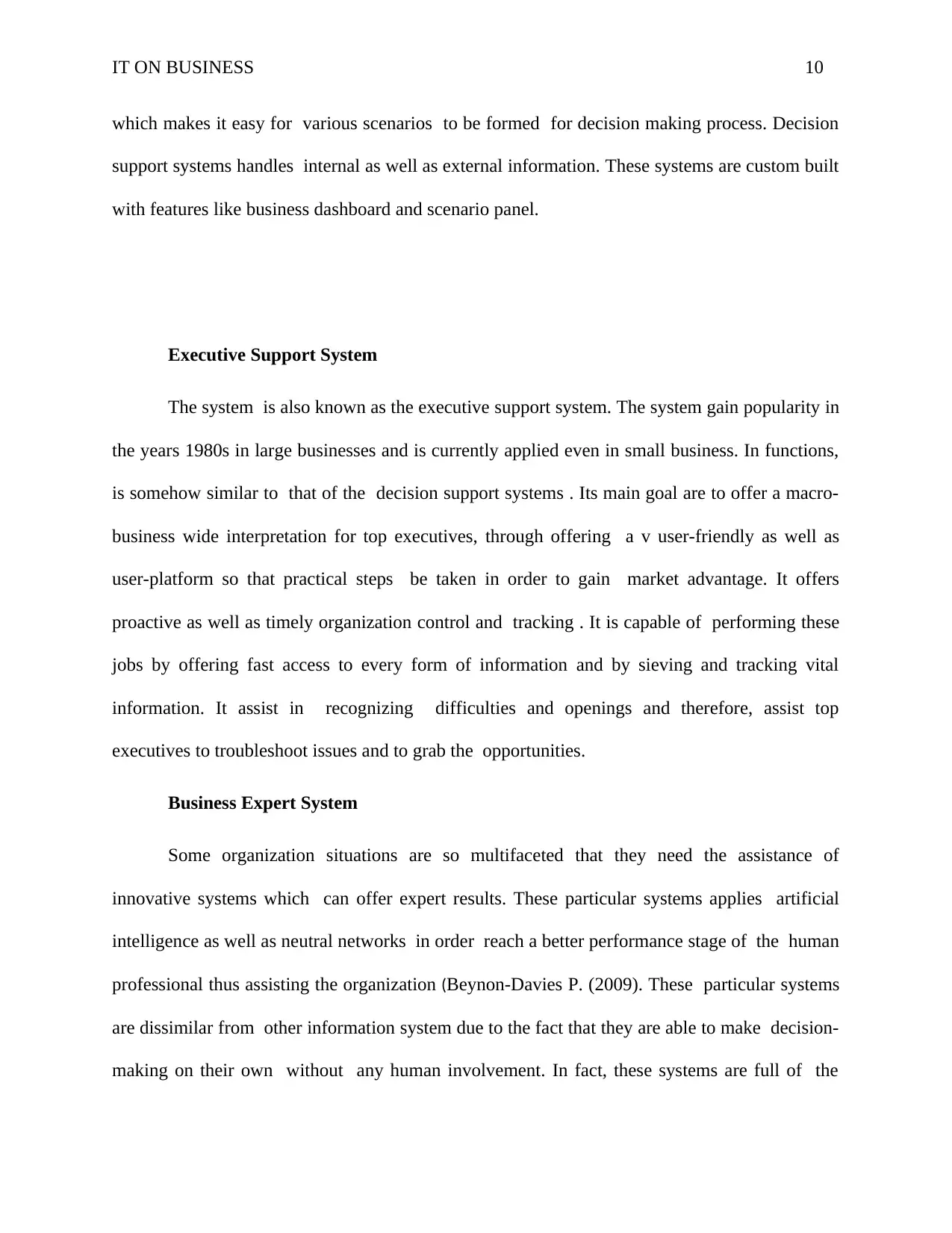
IT ON BUSINESS 10
which makes it easy for various scenarios to be formed for decision making process. Decision
support systems handles internal as well as external information. These systems are custom built
with features like business dashboard and scenario panel.
Executive Support System
The system is also known as the executive support system. The system gain popularity in
the years 1980s in large businesses and is currently applied even in small business. In functions,
is somehow similar to that of the decision support systems . Its main goal are to offer a macro-
business wide interpretation for top executives, through offering a v user-friendly as well as
user-platform so that practical steps be taken in order to gain market advantage. It offers
proactive as well as timely organization control and tracking . It is capable of performing these
jobs by offering fast access to every form of information and by sieving and tracking vital
information. It assist in recognizing difficulties and openings and therefore, assist top
executives to troubleshoot issues and to grab the opportunities.
Business Expert System
Some organization situations are so multifaceted that they need the assistance of
innovative systems which can offer expert results. These particular systems applies artificial
intelligence as well as neutral networks in order reach a better performance stage of the human
professional thus assisting the organization (Beynon-Davies P. (2009). These particular systems
are dissimilar from other information system due to the fact that they are able to make decision-
making on their own without any human involvement. In fact, these systems are full of the
which makes it easy for various scenarios to be formed for decision making process. Decision
support systems handles internal as well as external information. These systems are custom built
with features like business dashboard and scenario panel.
Executive Support System
The system is also known as the executive support system. The system gain popularity in
the years 1980s in large businesses and is currently applied even in small business. In functions,
is somehow similar to that of the decision support systems . Its main goal are to offer a macro-
business wide interpretation for top executives, through offering a v user-friendly as well as
user-platform so that practical steps be taken in order to gain market advantage. It offers
proactive as well as timely organization control and tracking . It is capable of performing these
jobs by offering fast access to every form of information and by sieving and tracking vital
information. It assist in recognizing difficulties and openings and therefore, assist top
executives to troubleshoot issues and to grab the opportunities.
Business Expert System
Some organization situations are so multifaceted that they need the assistance of
innovative systems which can offer expert results. These particular systems applies artificial
intelligence as well as neutral networks in order reach a better performance stage of the human
professional thus assisting the organization (Beynon-Davies P. (2009). These particular systems
are dissimilar from other information system due to the fact that they are able to make decision-
making on their own without any human involvement. In fact, these systems are full of the
Secure Best Marks with AI Grader
Need help grading? Try our AI Grader for instant feedback on your assignments.
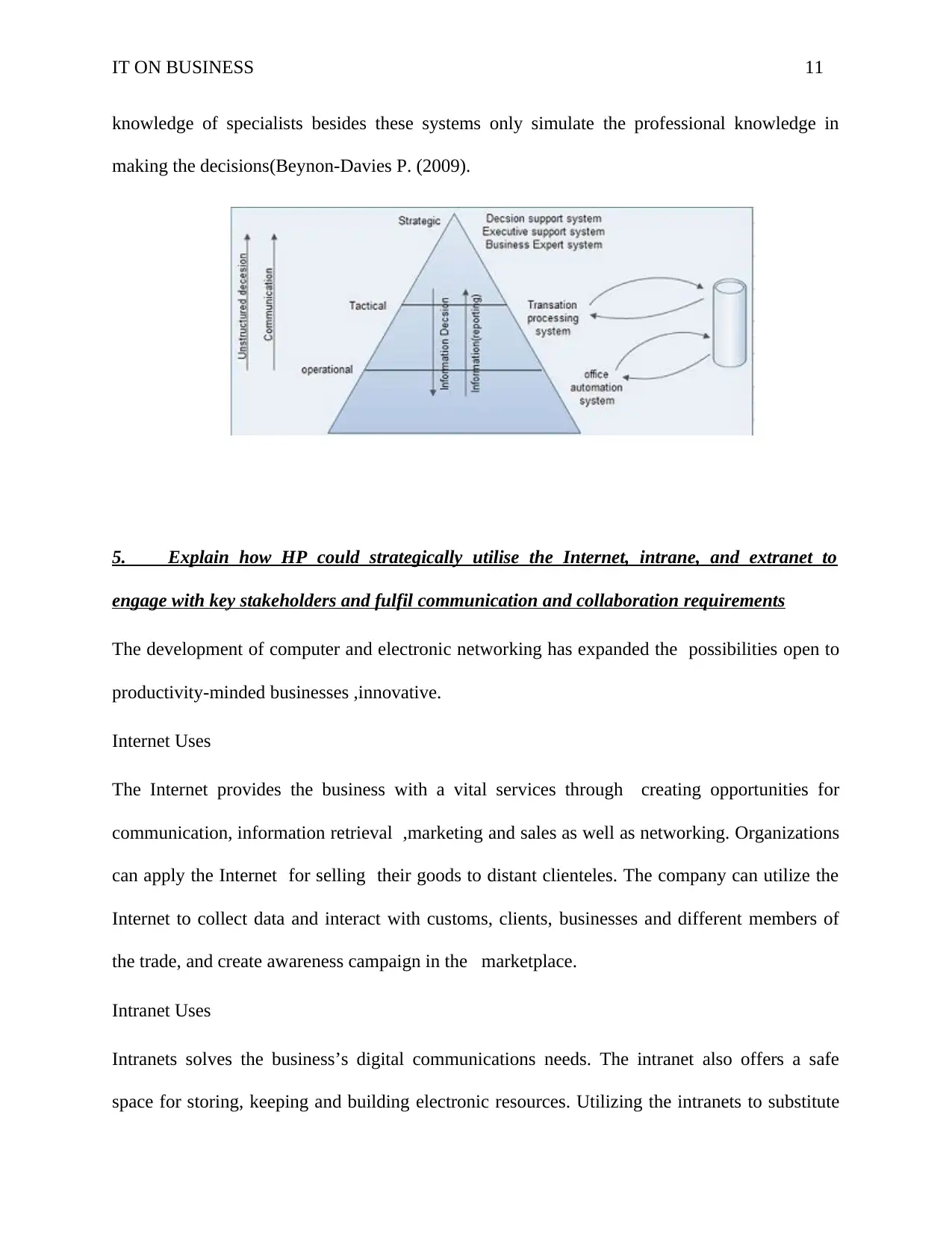
IT ON BUSINESS 11
knowledge of specialists besides these systems only simulate the professional knowledge in
making the decisions(Beynon-Davies P. (2009).
5. Explain how HP could strategically utilise the Internet, intrane, and extranet to
engage with key stakeholders and fulfil communication and collaboration requirements
The development of computer and electronic networking has expanded the possibilities open to
productivity-minded businesses ,innovative.
Internet Uses
The Internet provides the business with a vital services through creating opportunities for
communication, information retrieval ,marketing and sales as well as networking. Organizations
can apply the Internet for selling their goods to distant clienteles. The company can utilize the
Internet to collect data and interact with customs, clients, businesses and different members of
the trade, and create awareness campaign in the marketplace.
Intranet Uses
Intranets solves the business’s digital communications needs. The intranet also offers a safe
space for storing, keeping and building electronic resources. Utilizing the intranets to substitute
knowledge of specialists besides these systems only simulate the professional knowledge in
making the decisions(Beynon-Davies P. (2009).
5. Explain how HP could strategically utilise the Internet, intrane, and extranet to
engage with key stakeholders and fulfil communication and collaboration requirements
The development of computer and electronic networking has expanded the possibilities open to
productivity-minded businesses ,innovative.
Internet Uses
The Internet provides the business with a vital services through creating opportunities for
communication, information retrieval ,marketing and sales as well as networking. Organizations
can apply the Internet for selling their goods to distant clienteles. The company can utilize the
Internet to collect data and interact with customs, clients, businesses and different members of
the trade, and create awareness campaign in the marketplace.
Intranet Uses
Intranets solves the business’s digital communications needs. The intranet also offers a safe
space for storing, keeping and building electronic resources. Utilizing the intranets to substitute
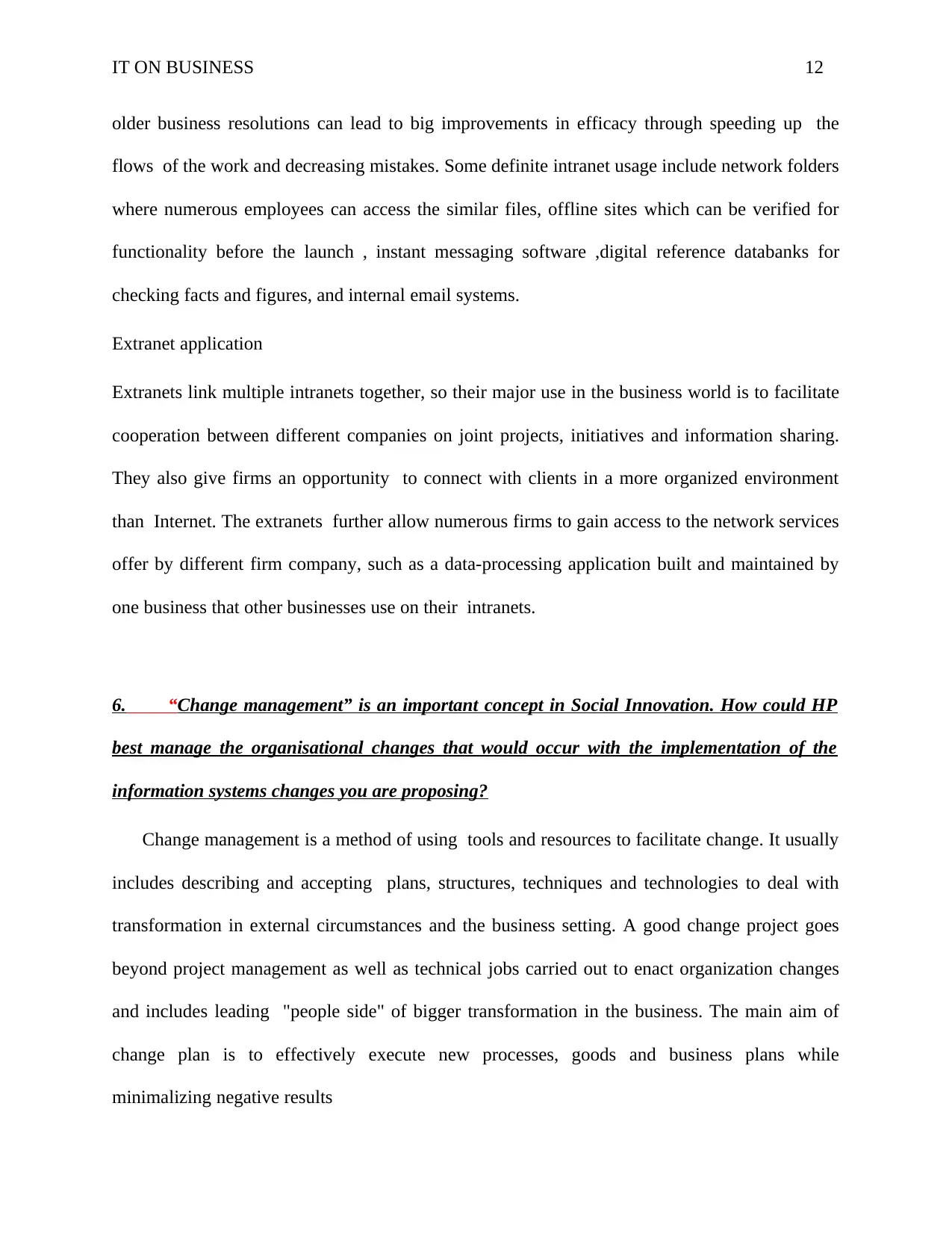
IT ON BUSINESS 12
older business resolutions can lead to big improvements in efficacy through speeding up the
flows of the work and decreasing mistakes. Some definite intranet usage include network folders
where numerous employees can access the similar files, offline sites which can be verified for
functionality before the launch , instant messaging software ,digital reference databanks for
checking facts and figures, and internal email systems.
Extranet application
Extranets link multiple intranets together, so their major use in the business world is to facilitate
cooperation between different companies on joint projects, initiatives and information sharing.
They also give firms an opportunity to connect with clients in a more organized environment
than Internet. The extranets further allow numerous firms to gain access to the network services
offer by different firm company, such as a data-processing application built and maintained by
one business that other businesses use on their intranets.
6. “Change management” is an important concept in Social Innovation. How could HP
best manage the organisational changes that would occur with the implementation of the
information systems changes you are proposing?
Change management is a method of using tools and resources to facilitate change. It usually
includes describing and accepting plans, structures, techniques and technologies to deal with
transformation in external circumstances and the business setting. A good change project goes
beyond project management as well as technical jobs carried out to enact organization changes
and includes leading "people side" of bigger transformation in the business. The main aim of
change plan is to effectively execute new processes, goods and business plans while
minimalizing negative results
older business resolutions can lead to big improvements in efficacy through speeding up the
flows of the work and decreasing mistakes. Some definite intranet usage include network folders
where numerous employees can access the similar files, offline sites which can be verified for
functionality before the launch , instant messaging software ,digital reference databanks for
checking facts and figures, and internal email systems.
Extranet application
Extranets link multiple intranets together, so their major use in the business world is to facilitate
cooperation between different companies on joint projects, initiatives and information sharing.
They also give firms an opportunity to connect with clients in a more organized environment
than Internet. The extranets further allow numerous firms to gain access to the network services
offer by different firm company, such as a data-processing application built and maintained by
one business that other businesses use on their intranets.
6. “Change management” is an important concept in Social Innovation. How could HP
best manage the organisational changes that would occur with the implementation of the
information systems changes you are proposing?
Change management is a method of using tools and resources to facilitate change. It usually
includes describing and accepting plans, structures, techniques and technologies to deal with
transformation in external circumstances and the business setting. A good change project goes
beyond project management as well as technical jobs carried out to enact organization changes
and includes leading "people side" of bigger transformation in the business. The main aim of
change plan is to effectively execute new processes, goods and business plans while
minimalizing negative results
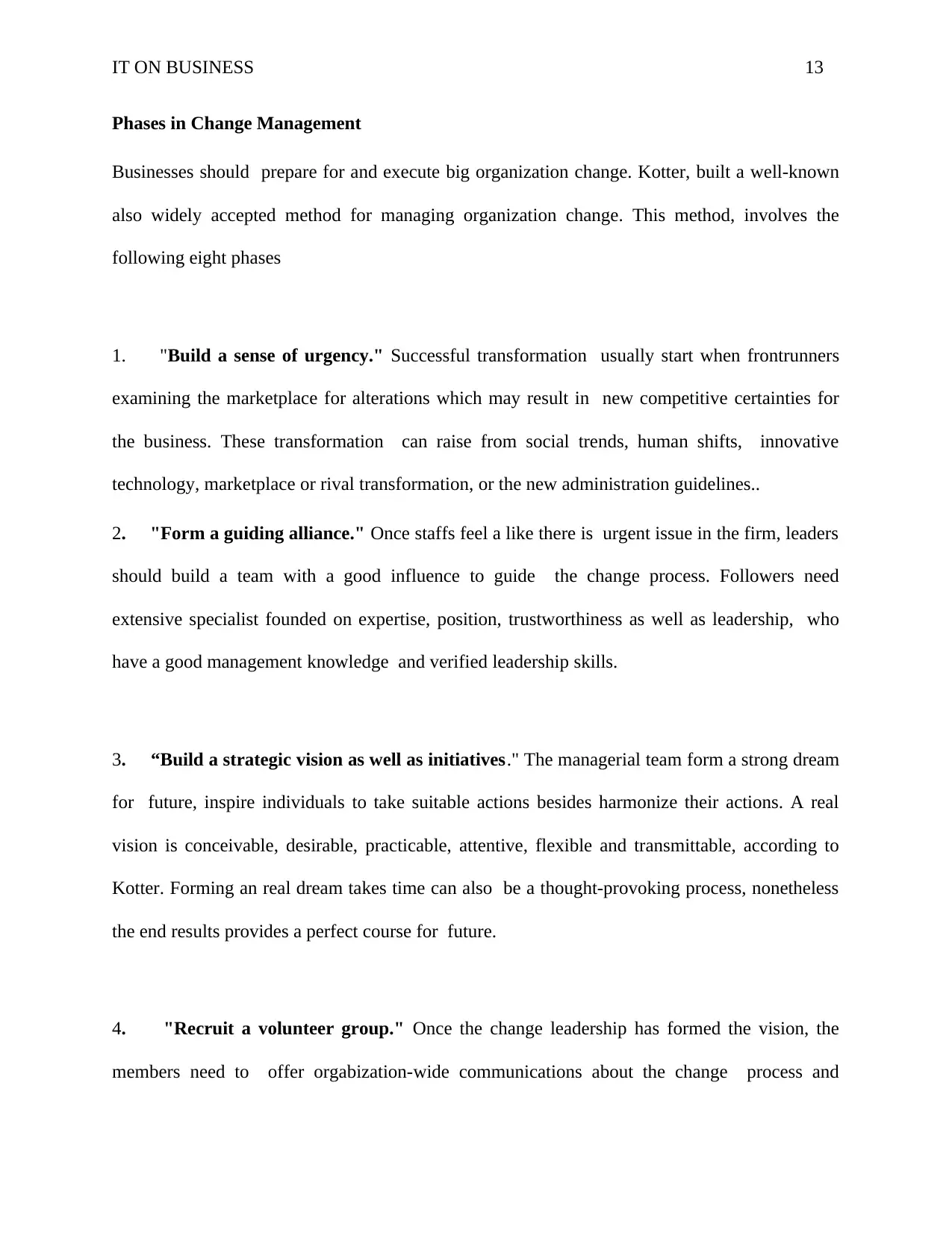
IT ON BUSINESS 13
Phases in Change Management
Businesses should prepare for and execute big organization change. Kotter, built a well-known
also widely accepted method for managing organization change. This method, involves the
following eight phases
1. "Build a sense of urgency." Successful transformation usually start when frontrunners
examining the marketplace for alterations which may result in new competitive certainties for
the business. These transformation can raise from social trends, human shifts, innovative
technology, marketplace or rival transformation, or the new administration guidelines..
2. "Form a guiding alliance." Once staffs feel a like there is urgent issue in the firm, leaders
should build a team with a good influence to guide the change process. Followers need
extensive specialist founded on expertise, position, trustworthiness as well as leadership, who
have a good management knowledge and verified leadership skills.
3. “Build a strategic vision as well as initiatives." The managerial team form a strong dream
for future, inspire individuals to take suitable actions besides harmonize their actions. A real
vision is conceivable, desirable, practicable, attentive, flexible and transmittable, according to
Kotter. Forming an real dream takes time can also be a thought-provoking process, nonetheless
the end results provides a perfect course for future.
4. "Recruit a volunteer group." Once the change leadership has formed the vision, the
members need to offer orgabization-wide communications about the change process and
Phases in Change Management
Businesses should prepare for and execute big organization change. Kotter, built a well-known
also widely accepted method for managing organization change. This method, involves the
following eight phases
1. "Build a sense of urgency." Successful transformation usually start when frontrunners
examining the marketplace for alterations which may result in new competitive certainties for
the business. These transformation can raise from social trends, human shifts, innovative
technology, marketplace or rival transformation, or the new administration guidelines..
2. "Form a guiding alliance." Once staffs feel a like there is urgent issue in the firm, leaders
should build a team with a good influence to guide the change process. Followers need
extensive specialist founded on expertise, position, trustworthiness as well as leadership, who
have a good management knowledge and verified leadership skills.
3. “Build a strategic vision as well as initiatives." The managerial team form a strong dream
for future, inspire individuals to take suitable actions besides harmonize their actions. A real
vision is conceivable, desirable, practicable, attentive, flexible and transmittable, according to
Kotter. Forming an real dream takes time can also be a thought-provoking process, nonetheless
the end results provides a perfect course for future.
4. "Recruit a volunteer group." Once the change leadership has formed the vision, the
members need to offer orgabization-wide communications about the change process and
Paraphrase This Document
Need a fresh take? Get an instant paraphrase of this document with our AI Paraphraser
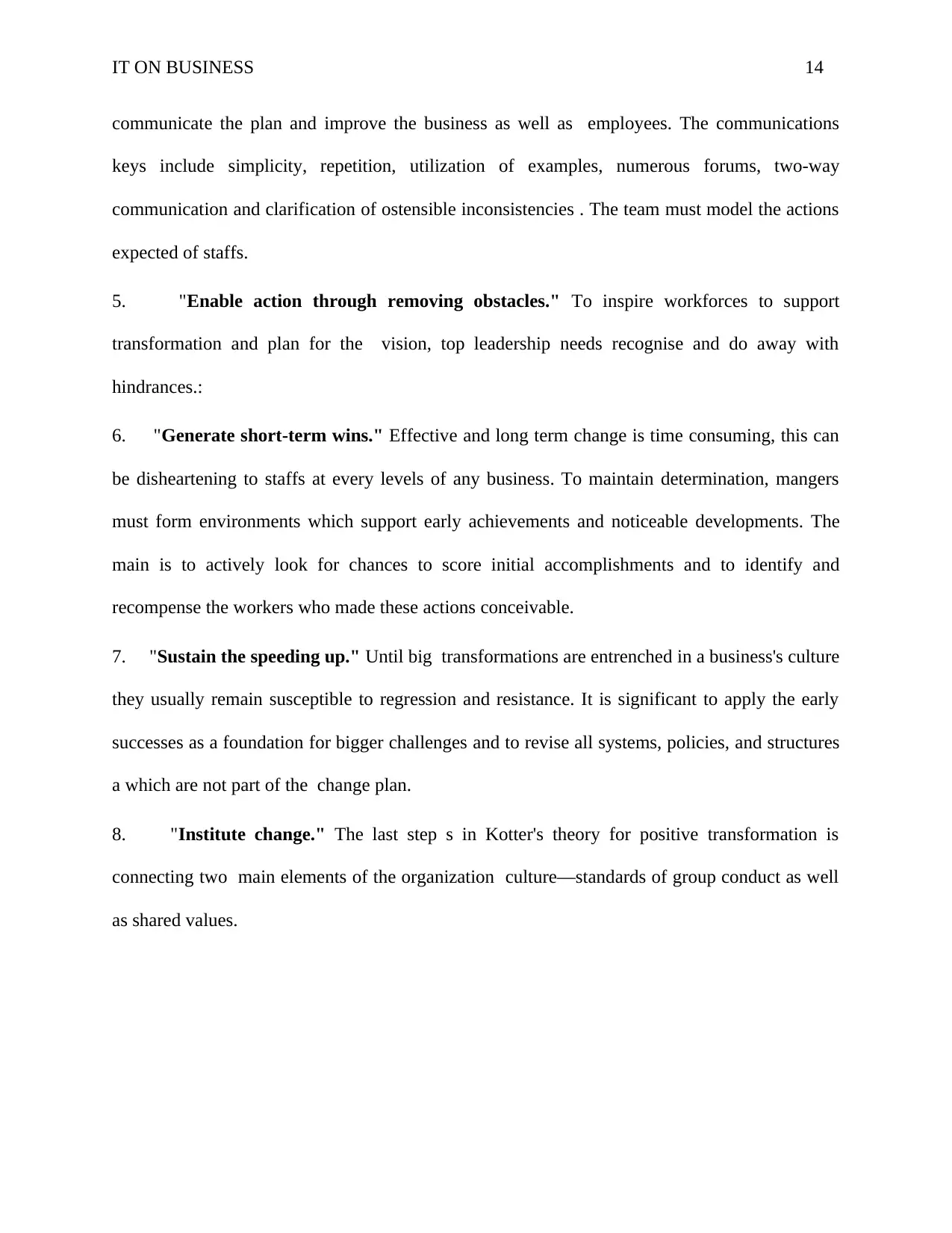
IT ON BUSINESS 14
communicate the plan and improve the business as well as employees. The communications
keys include simplicity, repetition, utilization of examples, numerous forums, two-way
communication and clarification of ostensible inconsistencies . The team must model the actions
expected of staffs.
5. "Enable action through removing obstacles." To inspire workforces to support
transformation and plan for the vision, top leadership needs recognise and do away with
hindrances.:
6. "Generate short-term wins." Effective and long term change is time consuming, this can
be disheartening to staffs at every levels of any business. To maintain determination, mangers
must form environments which support early achievements and noticeable developments. The
main is to actively look for chances to score initial accomplishments and to identify and
recompense the workers who made these actions conceivable.
7. "Sustain the speeding up." Until big transformations are entrenched in a business's culture
they usually remain susceptible to regression and resistance. It is significant to apply the early
successes as a foundation for bigger challenges and to revise all systems, policies, and structures
a which are not part of the change plan.
8. "Institute change." The last step s in Kotter's theory for positive transformation is
connecting two main elements of the organization culture—standards of group conduct as well
as shared values.
communicate the plan and improve the business as well as employees. The communications
keys include simplicity, repetition, utilization of examples, numerous forums, two-way
communication and clarification of ostensible inconsistencies . The team must model the actions
expected of staffs.
5. "Enable action through removing obstacles." To inspire workforces to support
transformation and plan for the vision, top leadership needs recognise and do away with
hindrances.:
6. "Generate short-term wins." Effective and long term change is time consuming, this can
be disheartening to staffs at every levels of any business. To maintain determination, mangers
must form environments which support early achievements and noticeable developments. The
main is to actively look for chances to score initial accomplishments and to identify and
recompense the workers who made these actions conceivable.
7. "Sustain the speeding up." Until big transformations are entrenched in a business's culture
they usually remain susceptible to regression and resistance. It is significant to apply the early
successes as a foundation for bigger challenges and to revise all systems, policies, and structures
a which are not part of the change plan.
8. "Institute change." The last step s in Kotter's theory for positive transformation is
connecting two main elements of the organization culture—standards of group conduct as well
as shared values.
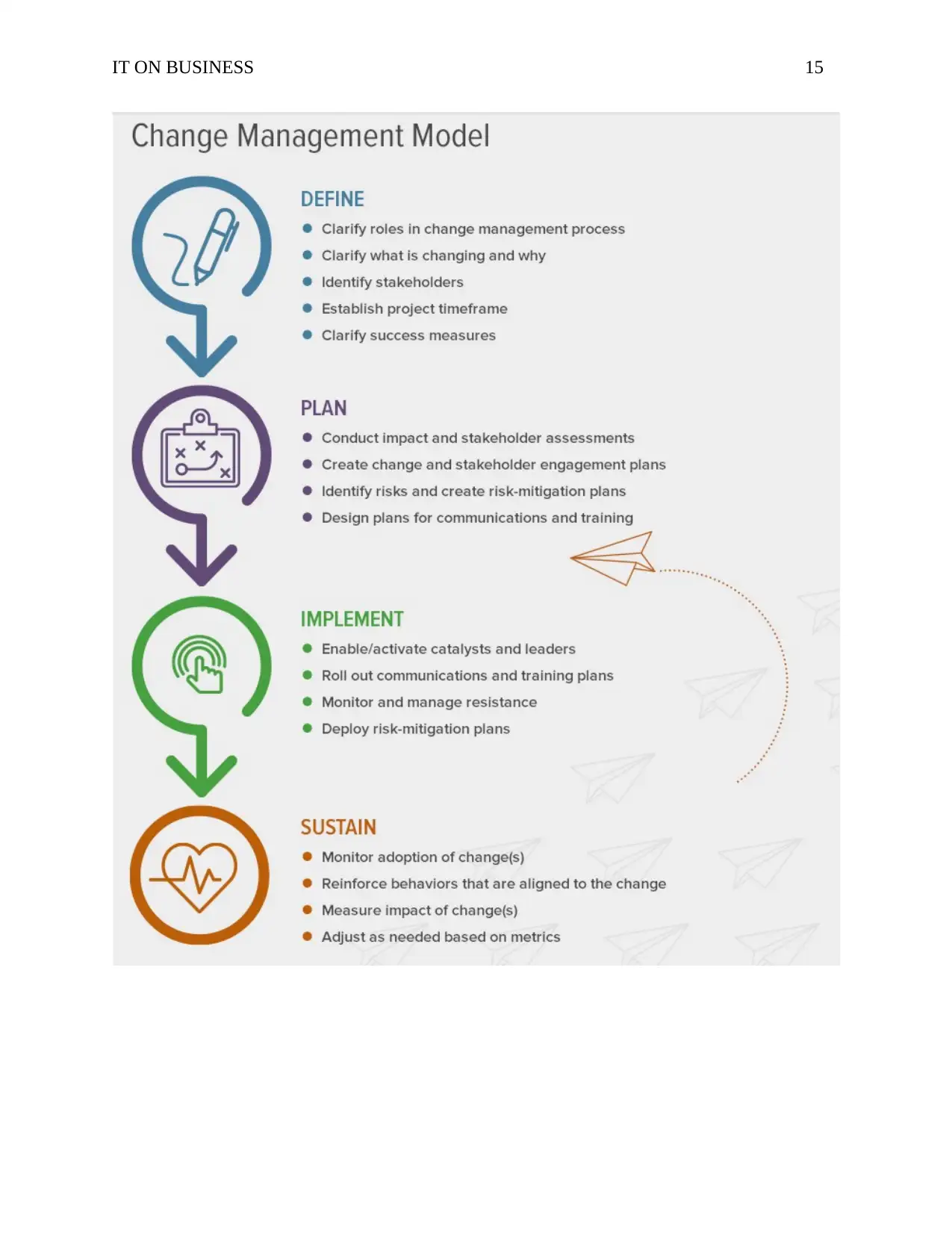
IT ON BUSINESS 15
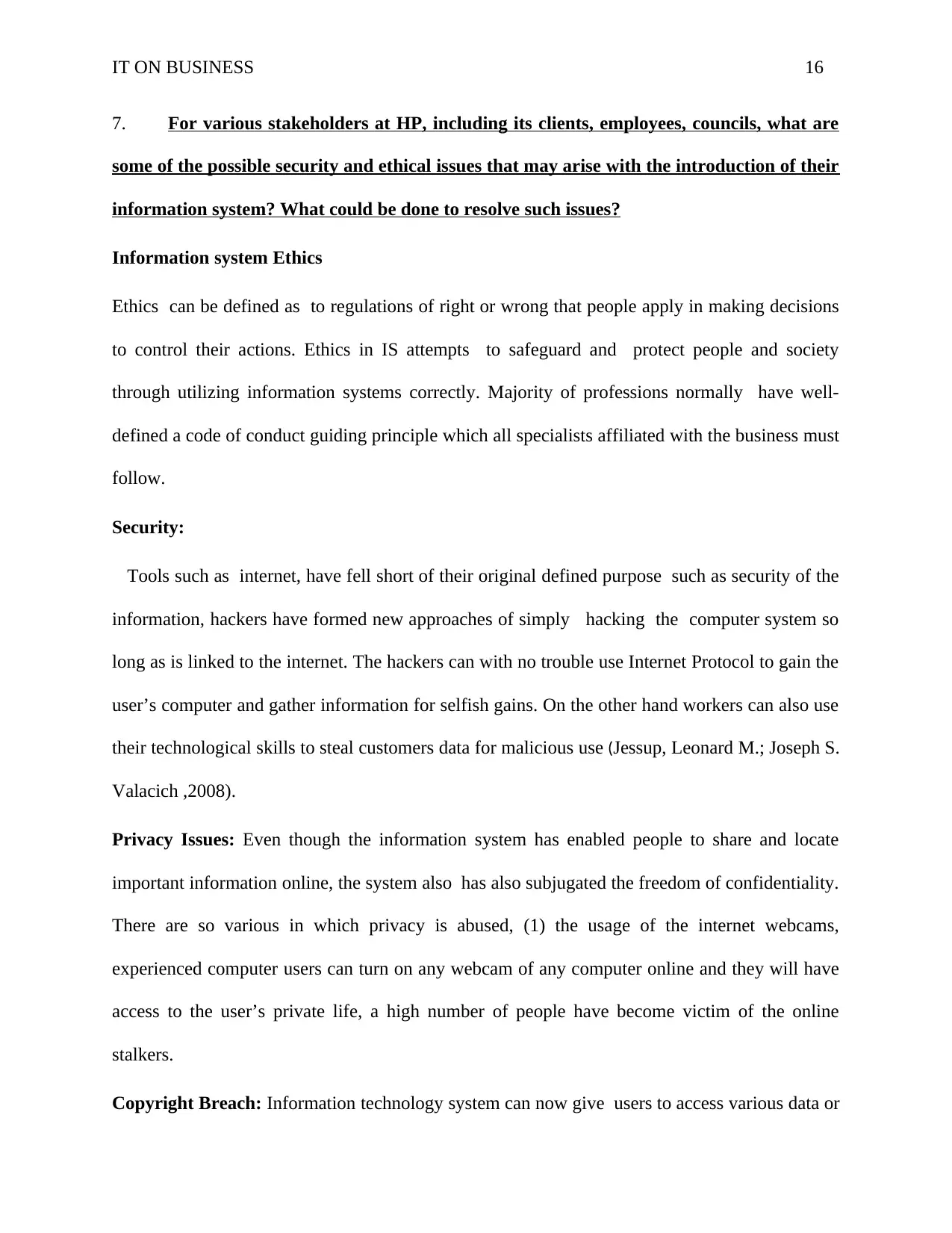
IT ON BUSINESS 16
7. For various stakeholders at HP, including its clients, employees, councils, what are
some of the possible security and ethical issues that may arise with the introduction of their
information system? What could be done to resolve such issues?
Information system Ethics
Ethics can be defined as to regulations of right or wrong that people apply in making decisions
to control their actions. Ethics in IS attempts to safeguard and protect people and society
through utilizing information systems correctly. Majority of professions normally have well-
defined a code of conduct guiding principle which all specialists affiliated with the business must
follow.
Security:
Tools such as internet, have fell short of their original defined purpose such as security of the
information, hackers have formed new approaches of simply hacking the computer system so
long as is linked to the internet. The hackers can with no trouble use Internet Protocol to gain the
user’s computer and gather information for selfish gains. On the other hand workers can also use
their technological skills to steal customers data for malicious use (Jessup, Leonard M.; Joseph S.
Valacich ,2008).
Privacy Issues: Even though the information system has enabled people to share and locate
important information online, the system also has also subjugated the freedom of confidentiality.
There are so various in which privacy is abused, (1) the usage of the internet webcams,
experienced computer users can turn on any webcam of any computer online and they will have
access to the user’s private life, a high number of people have become victim of the online
stalkers.
Copyright Breach: Information technology system can now give users to access various data or
7. For various stakeholders at HP, including its clients, employees, councils, what are
some of the possible security and ethical issues that may arise with the introduction of their
information system? What could be done to resolve such issues?
Information system Ethics
Ethics can be defined as to regulations of right or wrong that people apply in making decisions
to control their actions. Ethics in IS attempts to safeguard and protect people and society
through utilizing information systems correctly. Majority of professions normally have well-
defined a code of conduct guiding principle which all specialists affiliated with the business must
follow.
Security:
Tools such as internet, have fell short of their original defined purpose such as security of the
information, hackers have formed new approaches of simply hacking the computer system so
long as is linked to the internet. The hackers can with no trouble use Internet Protocol to gain the
user’s computer and gather information for selfish gains. On the other hand workers can also use
their technological skills to steal customers data for malicious use (Jessup, Leonard M.; Joseph S.
Valacich ,2008).
Privacy Issues: Even though the information system has enabled people to share and locate
important information online, the system also has also subjugated the freedom of confidentiality.
There are so various in which privacy is abused, (1) the usage of the internet webcams,
experienced computer users can turn on any webcam of any computer online and they will have
access to the user’s private life, a high number of people have become victim of the online
stalkers.
Copyright Breach: Information technology system can now give users to access various data or
Secure Best Marks with AI Grader
Need help grading? Try our AI Grader for instant feedback on your assignments.
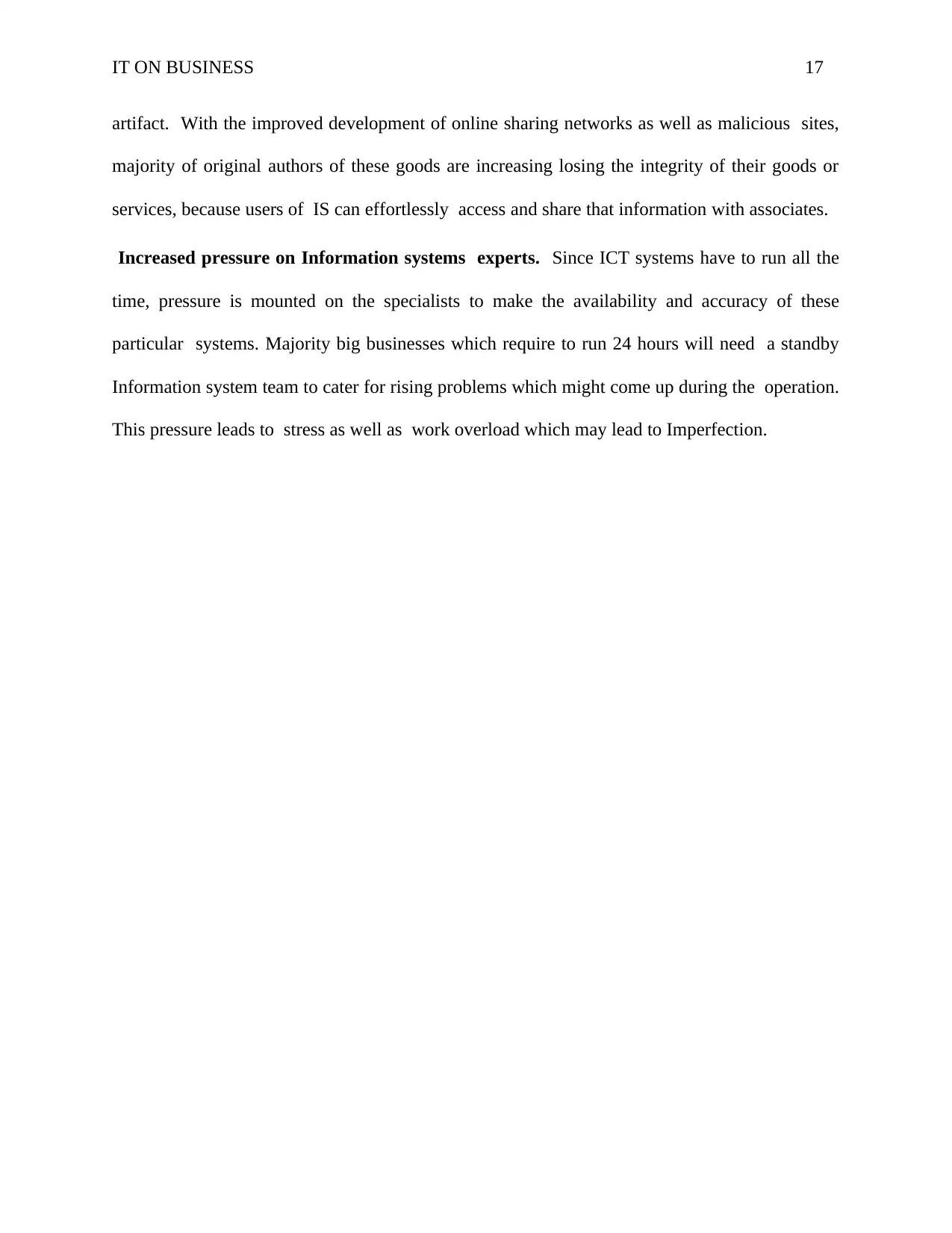
IT ON BUSINESS 17
artifact. With the improved development of online sharing networks as well as malicious sites,
majority of original authors of these goods are increasing losing the integrity of their goods or
services, because users of IS can effortlessly access and share that information with associates.
Increased pressure on Information systems experts. Since ICT systems have to run all the
time, pressure is mounted on the specialists to make the availability and accuracy of these
particular systems. Majority big businesses which require to run 24 hours will need a standby
Information system team to cater for rising problems which might come up during the operation.
This pressure leads to stress as well as work overload which may lead to Imperfection.
artifact. With the improved development of online sharing networks as well as malicious sites,
majority of original authors of these goods are increasing losing the integrity of their goods or
services, because users of IS can effortlessly access and share that information with associates.
Increased pressure on Information systems experts. Since ICT systems have to run all the
time, pressure is mounted on the specialists to make the availability and accuracy of these
particular systems. Majority big businesses which require to run 24 hours will need a standby
Information system team to cater for rising problems which might come up during the operation.
This pressure leads to stress as well as work overload which may lead to Imperfection.
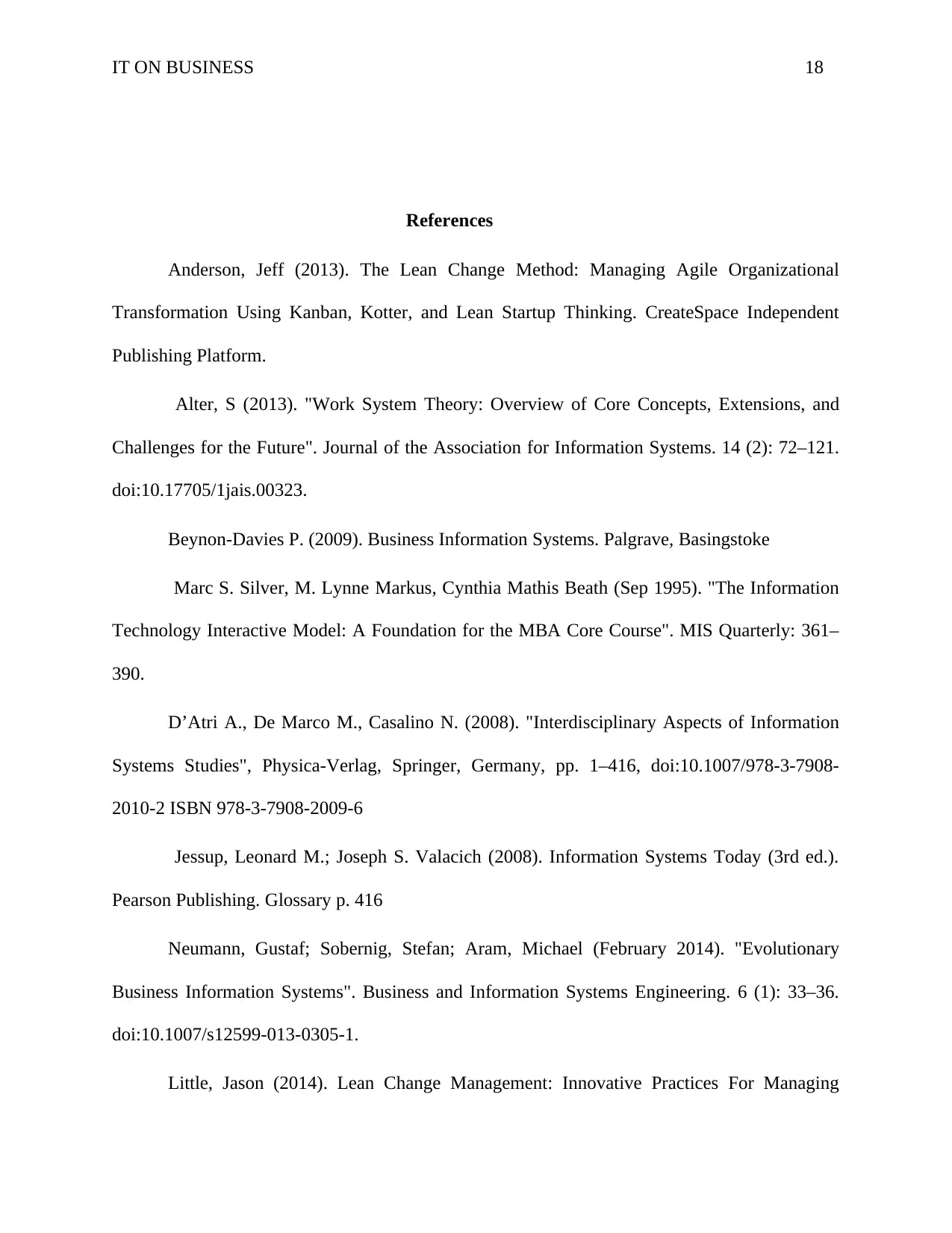
IT ON BUSINESS 18
References
Anderson, Jeff (2013). The Lean Change Method: Managing Agile Organizational
Transformation Using Kanban, Kotter, and Lean Startup Thinking. CreateSpace Independent
Publishing Platform.
Alter, S (2013). "Work System Theory: Overview of Core Concepts, Extensions, and
Challenges for the Future". Journal of the Association for Information Systems. 14 (2): 72–121.
doi:10.17705/1jais.00323.
Beynon-Davies P. (2009). Business Information Systems. Palgrave, Basingstoke
Marc S. Silver, M. Lynne Markus, Cynthia Mathis Beath (Sep 1995). "The Information
Technology Interactive Model: A Foundation for the MBA Core Course". MIS Quarterly: 361–
390.
D’Atri A., De Marco M., Casalino N. (2008). "Interdisciplinary Aspects of Information
Systems Studies", Physica-Verlag, Springer, Germany, pp. 1–416, doi:10.1007/978-3-7908-
2010-2 ISBN 978-3-7908-2009-6
Jessup, Leonard M.; Joseph S. Valacich (2008). Information Systems Today (3rd ed.).
Pearson Publishing. Glossary p. 416
Neumann, Gustaf; Sobernig, Stefan; Aram, Michael (February 2014). "Evolutionary
Business Information Systems". Business and Information Systems Engineering. 6 (1): 33–36.
doi:10.1007/s12599-013-0305-1.
Little, Jason (2014). Lean Change Management: Innovative Practices For Managing
References
Anderson, Jeff (2013). The Lean Change Method: Managing Agile Organizational
Transformation Using Kanban, Kotter, and Lean Startup Thinking. CreateSpace Independent
Publishing Platform.
Alter, S (2013). "Work System Theory: Overview of Core Concepts, Extensions, and
Challenges for the Future". Journal of the Association for Information Systems. 14 (2): 72–121.
doi:10.17705/1jais.00323.
Beynon-Davies P. (2009). Business Information Systems. Palgrave, Basingstoke
Marc S. Silver, M. Lynne Markus, Cynthia Mathis Beath (Sep 1995). "The Information
Technology Interactive Model: A Foundation for the MBA Core Course". MIS Quarterly: 361–
390.
D’Atri A., De Marco M., Casalino N. (2008). "Interdisciplinary Aspects of Information
Systems Studies", Physica-Verlag, Springer, Germany, pp. 1–416, doi:10.1007/978-3-7908-
2010-2 ISBN 978-3-7908-2009-6
Jessup, Leonard M.; Joseph S. Valacich (2008). Information Systems Today (3rd ed.).
Pearson Publishing. Glossary p. 416
Neumann, Gustaf; Sobernig, Stefan; Aram, Michael (February 2014). "Evolutionary
Business Information Systems". Business and Information Systems Engineering. 6 (1): 33–36.
doi:10.1007/s12599-013-0305-1.
Little, Jason (2014). Lean Change Management: Innovative Practices For Managing

IT ON BUSINESS 19
Organizational Change. Happy Melly Express
Piccoli, Gabriele; Pigni, Federico (July 2018). Information systems for managers: with
cases (Edition 4.0 ed.). Prospect Press. p. 28. ISBN 978-1-943153-50-3. Retrieved 25 November
2018.
Organizational Change. Happy Melly Express
Piccoli, Gabriele; Pigni, Federico (July 2018). Information systems for managers: with
cases (Edition 4.0 ed.). Prospect Press. p. 28. ISBN 978-1-943153-50-3. Retrieved 25 November
2018.
1 out of 19
Related Documents
Your All-in-One AI-Powered Toolkit for Academic Success.
+13062052269
info@desklib.com
Available 24*7 on WhatsApp / Email
![[object Object]](/_next/static/media/star-bottom.7253800d.svg)
Unlock your academic potential
© 2024 | Zucol Services PVT LTD | All rights reserved.





